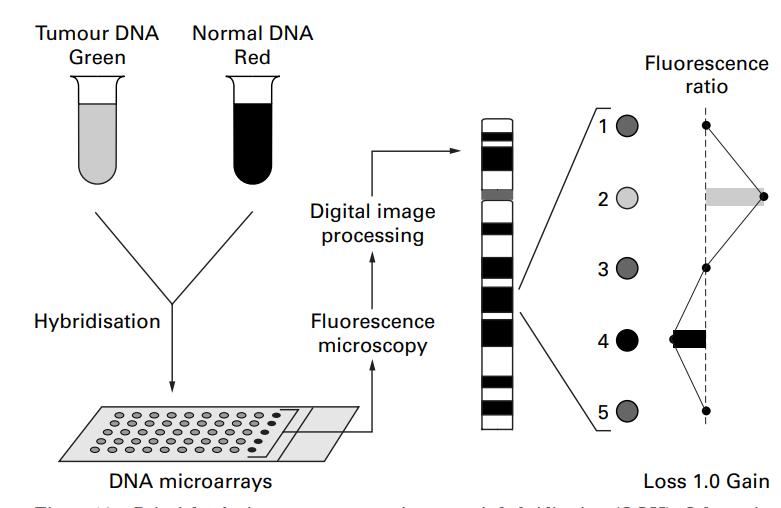Comparative Genomic Hybridization and Its Applications
Comparative genomic hybridization (CGH) is a technique that permits the detection of chromosomal copy number changes without the need for cell culturing. Simultaneous hybridization of differentially labeled test DNA and normal reference DNA with normal metaphase chromosomes can provide a global overview of chromosome gains and losses in the entire genome. It allows the analysis of the entire genome in a single experiment. CGH is based on the principles of fluorescent in situ hybridization (FISH). The result of the hybridization is imaged with a fluorescence microscope, karyotyped, and computerized.
 Fig.1 Principle of microarray CGH. (Weiss MM, et al., 1999)
Fig.1 Principle of microarray CGH. (Weiss MM, et al., 1999)
Traditional & Micro CGH Analysis
- Comparative genomic hybridization (CGH) can be used for comprehensive low-resolution analysis of chromosomal imbalances of an entire human genome. The so-called microdissection-based comparative genomic hybridization (micro-CGH) technique allows the molecular cytogenetic investigation of harvested and cytogenetically fixed interphase nuclei. The CGH method is mainly used in cytogenetics for the detection of unbalanced chromosomal aberration in tumors.
- Creative Bioarray provides a platform for traditional CGH analysis and optional micro-CGH analysis based on FISH services. This service can be used for cytogenetic analysis of solid tumor samples. The basic process of traditional CGH analysis includes sample preparation, probe preparation, FISH hybridization, staining, imaging, and data analysis. In addition, we provide independent micro-CGH services, and we have independent experiments to complete chromosome microdissections.
High-Resolution CGH
- It differs from classical CGH in the way of software processing of the captured fluorescence image. It uses dynamic standard reference intervals (natural variation of fluorescence intensities of chromosome pairs) instead of fixed ones. Dynamic values are obtained by statistically processing the deviations of control profiles in individuals with a normal karyotype.
- The advantage of the method is the resolution at the level of 4-5 Mb and the possibility of detecting aberrations even at 20–30% clonal representation.
Array CGH Analysis
- Hybridization of fluorescently labeled probes of the DNA under investigation and reference DNA with many specific DNA sequences (instead of chromosomes). The genome is thus divided into small sections and arranged in a grid (microarray, biochip). The individual sections have a precise location and can thus represent individual genes or parts of genes.
- Array CGH has many research applications including cancer profiling, gene discovery, and understanding epigenetic modifications and chromatin conformation. The results from such investigations can be directly correlated to genomic locations and gene expression.
- Creative Bioarray provides Array CGH Services, a high-resolution karyotype analysis solution, for the detection of unbalanced structural and numerical chromosomal alterations with high-throughput capabilities. In addition, a wide range of Karyotyping Services (Traditional Karyotyping-G Banded, M-FISH, Molecular Karyotyping, etc.) is provided to meet our customer's different needs.
Reference
- Weiss MM, et al. (1999). "Comparative genomic hybridization." Mol Pathol. 52 (5), 243-51.